Trees with character: The story behind the monumental Parrotia Persica
31/10/2023 - 07:53
An Instagram post by B-Garden Bv recently caught our attention. An overnight transport - "convoi exceptionnel" was carrying a large tree. Where did it come from? And most importantly, where was it going? We contacted Emile Beel, owner of B-Garden Bv in Belgium: it turned into an enlightening and entertaining conversation.
Hi Emile. What can you tell us about that tree and the project?
The client initially planned to plant three individual trees, but upon evaluating the location, it became clear that a multi-stem tree would be more suitable. The property is situated in a nature reserve, adjacent to the Latem Meersen, a vast lake region with wet meadows along the River Lys. Traditional, single-stem trees wouldn’t have been as visually appealing during the winter in such an expansive, open area. Opting for a multi-stem tree would enhance the garden’s overall appeal and character. But technically speaking this is not a real multi-stem tree as it starts on a short single trunk and then goes very wide. Regardless, it’s a stunning tree.
The tree provides plenty of shade: in summer, the ideal spot for the owner to read his book.

Still with the original idea of the 3 standard trees in mind, I visited solitair tree nursery in Loenhout. Here’s a tip: it’s a fascinating place worth visiting. I often find myself there on Sundays, my day off, drawing inspiration for various projects. The nursery specializes in solitary plants, boasting over 100 hectares of incredibly beautiful plants in a multitude of shapes and sizes.
During my visit to the nursery, I wandered around with a few ideas in mind but didn’t find anything instantly captivating. Then, unexpectedly, a Parrotia persica caught my eye—it was the largest of its kind there, with an estimated age of 55-65 years. The tree had been a part of the nursery for nearly four decades, receiving extensive pruning over the years, which was evident from its distinct silhouette. The client, too, was instantly captivated, entrusting me fully with the project after only seeing a photograph of the tree. The decision was made to choose this particular tree, and the client first laid eyes on it at the nursery, roughly a month before it was transplanted.
Now, a challenging task awaited me: the tree had a massive weight of over 5 tonnes and spanned a width of 4 meters. Consequently, special transportation had to be arranged due to its extraordinary size.
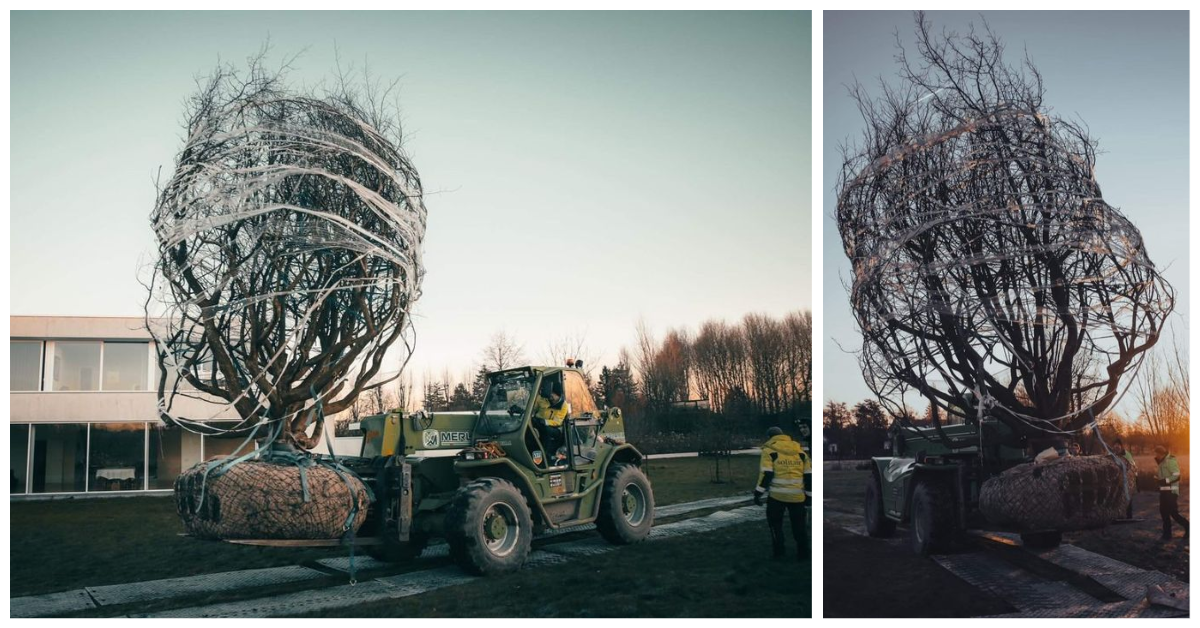
The digging out alone must have been a massive job?
That wasn't too bad in itself. The root ball was not that overly large compared to the tree.
Can you tell us more about the plant hole?
We prepared a planting hole that was at least twice the size of the tree's root ball. Since the tree was destined to be the centrepiece of the garden, it was imperative to plant it flawlessly. The customer participated in deciding its placement and its orientation. Given that they spend a lot of time in the kitchen, it made sense to position the most appealing side of the tree to face that area.
We used 1.4kg/m³ TerraCottem arbor to mix in with the soil from the planting hole.
How long did the placement itself take?
The actual placement took 1 day. Transport arrived at 6am. At about 11am, the tree was in the pit. Then backfilling and anchoring began. In the evening, everything was neatly finished, including eliminating the transport tracks.
Was this the first time you planted such a large tree?
I had planted several large trees before, but this one was by far the largest, especially in terms of budget (laughs). The cost was comparable to that of a small car, excluding installation and transportation costs.
It was quite a challenging task, even more so with the regulations for transportation. We had to apply for a permit from the Sint-Martens-Latem municipality. They gave us a very strict window for transportation, requiring everything to be done within a short timeframe and only along specific routes, among other things.
From the initial contact with the client to the final placement, how much time did it take?
The entire project took just under a year. Approval was given just before the summer of 2021. Additionally, we also wanted to give the nursery enough time to properly care for and prepare the tree for transportation. For instance, the tree was pre-cut and removed from the planting hole beforehand. It then remained out of the ground at the nursery for another 2-3 months, fully rooted and placed on a pallet, to observe how it would react outside the ground.
The tree was finally planted at its permanent location on February 28, 2022.
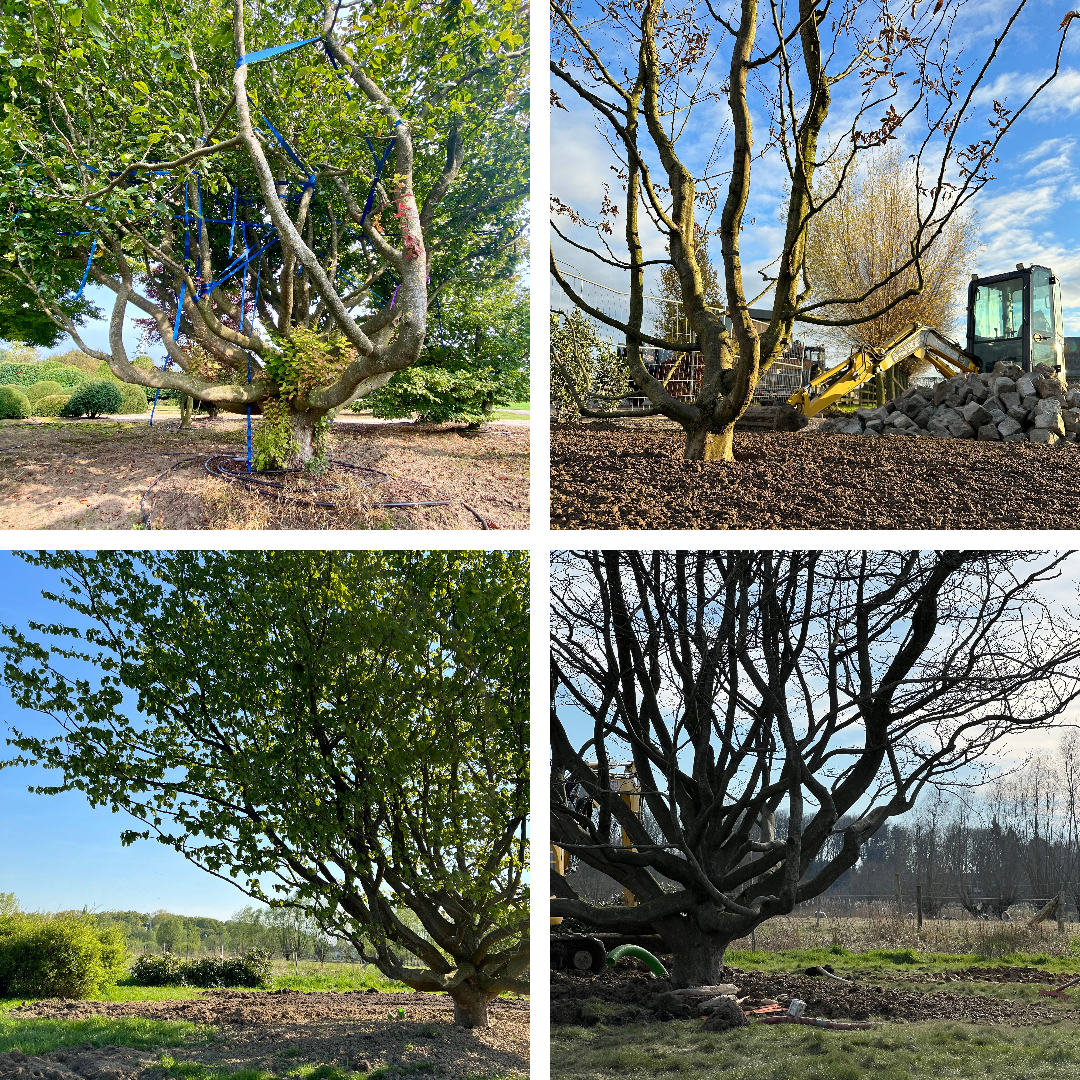
How did the client find you?
Well, it was through word of mouth, actually. That’s how we acquire most of our clients. We operate within a clientele that values privacy highly, which makes it not always possible to share photos on social media.
| Some data: | |
|---|---|
| Species: | Parrotia persica (Perzian ironwood) |
| Estimated age: | 55 to 65 years old |
| Weight: | + 5 tonnes |
| Diameter of crown (unbound): | 7m |
| Diameter of crown (bound): | 4m |
| Tension straps for binding the tree: | 50-60 |
| Size of root ball: | 90cm (H) x 220cm (Ø) |
| Duration of placement: | 1 day |
| Project duration: | +/- 2 years |
Why did you become a landscape gardener, Emile?
My primary goal was to create beautiful gardens and work with quality materials. We don’t particularly enjoy public tenders because they don’t allow us to put as much of our soul into the projects. We aim to create gardens with unique characters and styles.
You mentioned 'we': how many people are on the B-Garden BV team?
Currently, I have two permanent employees, but I also frequently collaborate with subcontractors and/or student workers. I have an amazing and competent team. Actually, I am still looking for more people, but finding them in our industry isn’t always easy. Working in various weather conditions, long days, and seasonal shifts are not appealing to everyone. Finding young individuals to strengthen the team proves to be a real challenge.
How long has B-Garden BV been in existence?
I started when I was 18 years old. Now, I am 25, so it has been around for 7 years. I began as a student-entrepreneur and established a sole proprietorship when I was 20.
In which region do you operate?
Our coverage is quite extensive. About 70-80% of our work is around the Gent area: places like Sint-Denijs-Westrem, Sint-Martens-Latem, Gent itself, Zwijnaarde, De Pinte, Nazareth, let’s say between Gent and Oudenaarde. We also have a few clients closer to the coastal regions, and we’ve completed projects in Kortrijk, Antwerp, among others, but those are rather sporadic. We try to limit long distances for practical reasons.
What sets B-Garden BV apart from the "competition"?
(laughs)... that’s a tough question. I don’t really see other landscape gardeners as competitors. They are all colleagues, each with their own style.
We also strive to maintain our own unique style, aiming to be original and not repetitive. This is even reflected in aspects like our logo and our van, for instance. It’s not the typical white with a green tree on it. Ours is blue, adorned with many leaves.
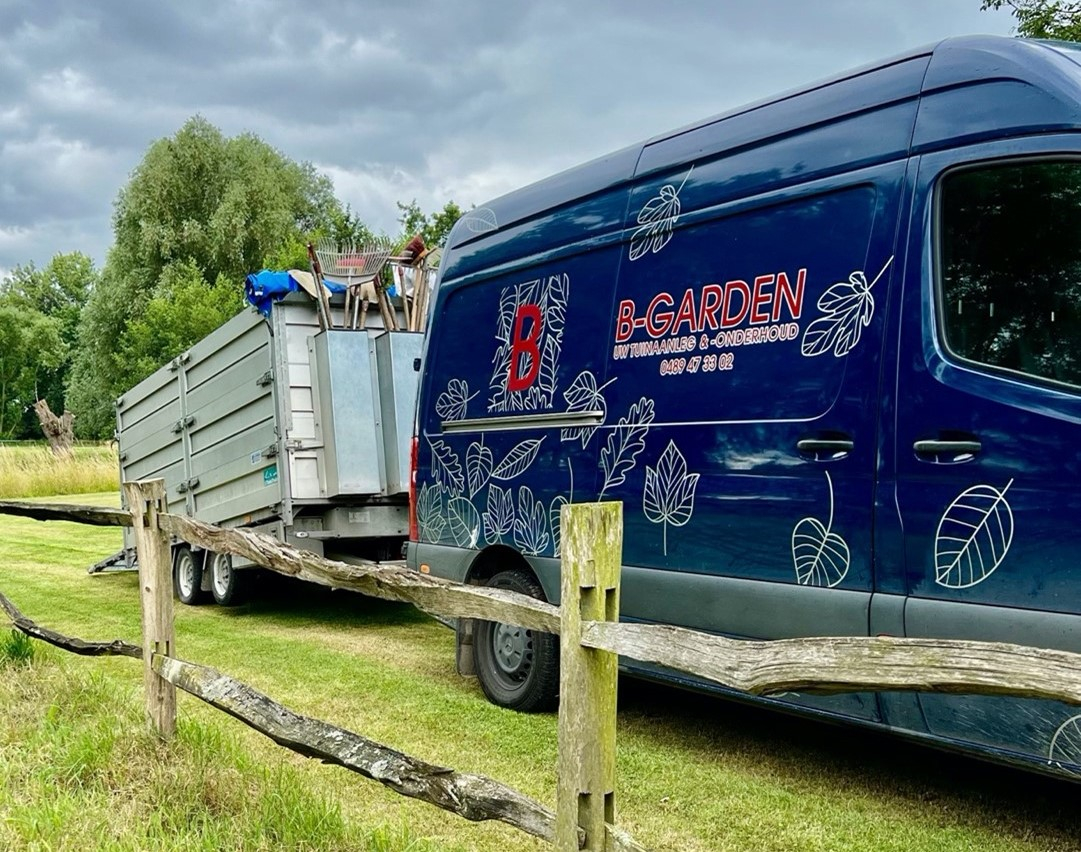
We try not to go with the flow. And put our own feelings into the projects as much as possible. That is often a challenge, but usually succeeds.
"Often when we do designs, I visit the arborist FIRST to see what is available. We tend to design our gardens centred around a tree. So, it’s more common for us to find a project suited to a tree rather than finding a tree for a project (laughs)."
That's our vision: the feeling has to be right. Greenery can do a lot!
What did you study?
I did a general ASO education. That didn't go without a hitch (laughs): in fact, it just wasn't my thing and I also had glandular fever for a period. Finally, I did my last 2 years of horticultural school in Melle (Tectura) and graduated there.
In fact, I was doing garden maintenance from the age of 14-15: joining my grandfather in the garden, helping out at friends' houses, holiday jobs, etc. That's basically how I got into it. I started with maintenance, but gradually more gardening came along. And so I kept growing into what B-Garden is today.
Do you do design as well as construction?
I only design smaller projects. I have a nice collaboration with my brother, who is an architect. I have the plant knowledge and he has the "what's where" feeling.
With him, I did a very nice project in Oudenaarde. We carefully demolished the old wall of the stables, a bluestone, and made stepping stones out of it.
Photographer Studio Salien - Office Rv Architects
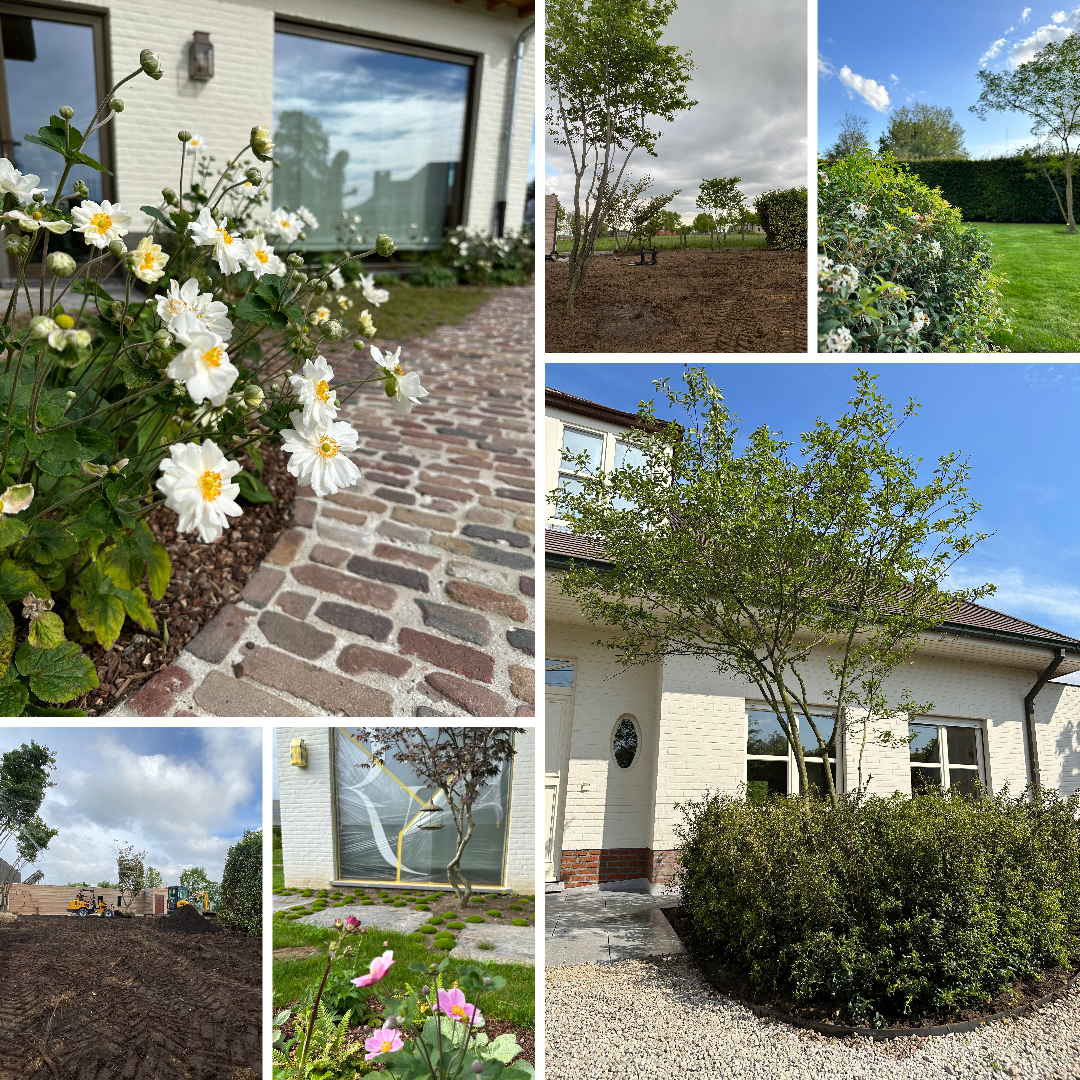
I also work with a number of landscape architects, e.g. Erik De Waele: a true nature lover. Together with Erik Dhondt and Wirtz, in my view the top 3 landscape architects in our sector.
Why do these 3 landscape architects appeal to you the most?
They can very nicely make what has been landscaped blend into the surrounding nature. And make it one whole. They are very good with nature and play with the natural elements there.
For example, we now have a project with Erik De Waele: a garden next to a fen area. Erik's philosophy is to work with the landscape. The garden should go along with nature: native species, something "wilder".
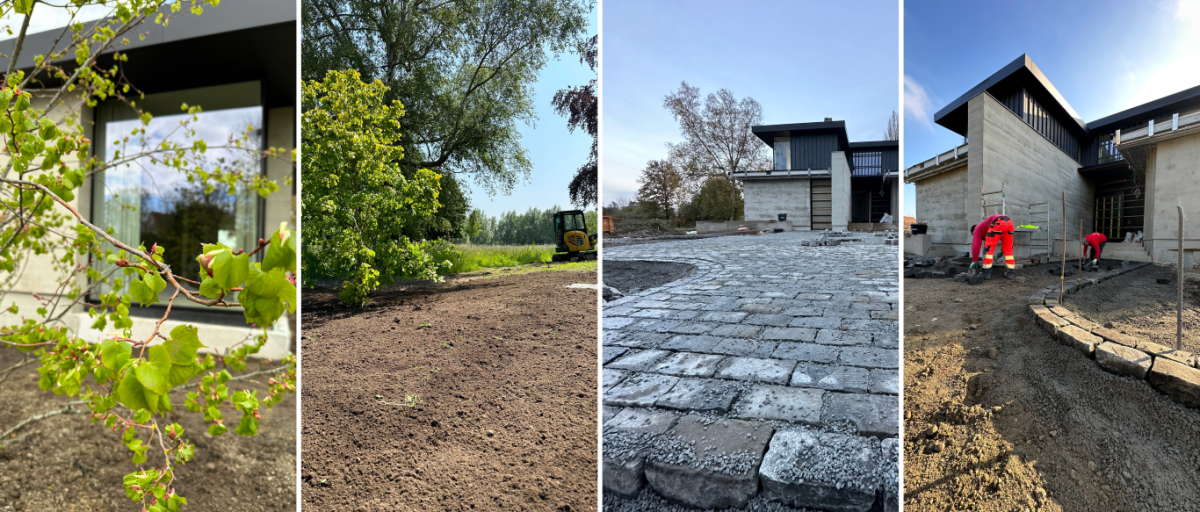
Architect Simon de Burbure - Garden and landscape architect Erik de Waele
The landscape architect draws, B-garden executes... who then decides to use soil conditioner for example?
This is usually written in the specifications, but not always in great detail. It is often me who recommends specific products to the customer, such as TerraCottem. So, it is done in consultation, but soil improvement is a requirement. To reduce the risk of failure.
Is it challenging to convince customers to use soil improvement?
In fact, no. When it comes to larger projects and trees, the extra cost of a few bags of soil conditioner doesn't really matter that much. On smaller projects or in public tenders, this can sometimes be a point of discussion.
The tree in the project in Sint-Martens-Latem, for example, was a unique specimen. It is irreplaceable and therefore "had" to grow (laughs).
Why do you use TerraCottem?
"I often put TerraCottem soil conditioner in my tenders as standard. As a "certainty", to be more confident that the bigger plants will do well."
I did a project a few years back where it wasn't provided: the client didn't want to invest in it. He went on a trip for a month and coincidentally his irrigation system failed at that time. As a result, much of the plants died. Those are moments where you learn a lesson the hard way-
Where do you get your products?
I often go to Callens in Eke. And occasionally at Intergrow. By the way, I like both of them very much when it comes to recommending their products.
I often get my compost and the like from Acterra in Deinze. All their substrates are always perfect. Never had any quality problems with them.
Worst-case scenario: the Parrotia persica dies... do you bear the responsibility?
Basically, we are responsible. But I was pretty comfortable with it:
- we put a sensor in the ground, which allows us to measure the moisture content from a distance,
- the customer also has green fingers, he is constantly busy in the garden,
- there is the soil conditioner,
- finally, the tree nursery also does a number of preventive things: they regularly transplant their trees. They first undercut them small, let them re-root and then undercut them large. This way, the trees are better armed against transplant shock. This is why they like to be given enough time between purchase and final planting.
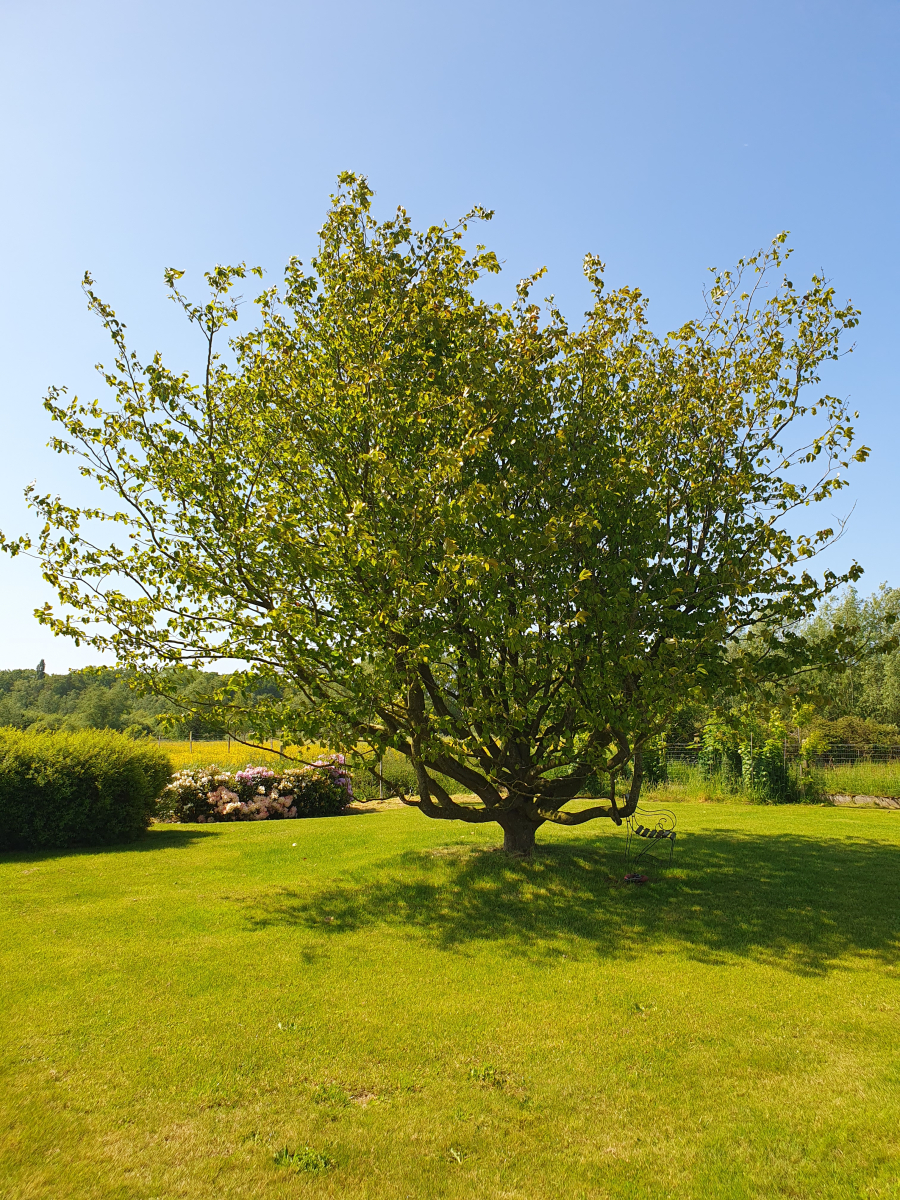
Do you give a guarantee for all the jobs you do?
We put in our conditions that certain measures must be taken. We cannot foresee everything, of course. Last year, for example, we had periods with temperatures above 30°C. We don't have time to start watering everywhere. Therefore, it is also up to the client to take some responsibility. But that is difficult to control, of course. That is why we put a sensor in some places. Or we work with automated sprinklers, which we can control remotely. To avoid watering too little or too much. Watering is always a sensitive issue. But TerraCottem helps with that, he (laughs).
Do you often return to completed garden? For maintenance, for instance?
Yes, in fact that's kind of our set-up. When I started B-Garden, I soon realised that a lot of landscapers like to build gardens but prefer not to do the maintenance. We really try to attract our own customers and then, within our means of course, also provide maintenance.
But the more clients, the more maintenance, the less time... This brings us back to the point of looking for suitable staff (laughs). It's a bit of a vicious circle.
What do you like most about your job?
It is a job that is very fulfilling. Creating something is magical. The client cannot always imagine what the end-result will be. The landscape architects help us a lot with that, with sketches and 3D images. But showing the end-result to clients, that started from a white sheet, and having them say "wow!"... that's what we do it for.
"Giving a garden soul and character, where people can relax after a long day at work. That's the main goal."
Thanks for the nice chat, Emile. Good luck with your future projects!
More information about Emile?
B-GARDEN BV
Graaf Van Hoornestraat 71
9850 Nevele, Belgium
T: 0489 47 33 02
E: b_garden@outlook.com
W: www.bgarden.be
Instagram bgarden_bv
If you know someone who would also like to read this article, feel free to copy the link and share.
Would you like to be in the spotlight too?
You can!
Send a quick email to marketing@terracottem.be and we will schedule an online meeting together.
Would you like more information about TerraCottem arbor soil conditioner?
Contact usWould you like more information about TerraCottem arbor soil conditioner?
Contact usTerraCottem Intl. SL
Apartado de Correos 4511190 Benalup (Cádiz)Spain
